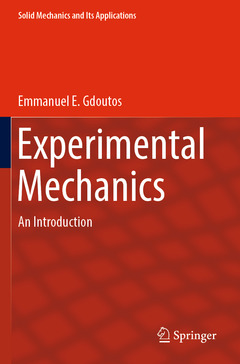Description
Experimental Mechanics, 1st ed. 2022
An Introduction
Solid Mechanics and Its Applications Series, Vol. 269
Author: Gdoutos Emmanuel E.
Language: English
Keywords
Experimental mechanics; Optical methods in stress analysis; Strain gages; Geometric and interferometric moiré; Photoelasticity; Interferometry; Holography; Caustics; Speckle methods; Digital image correlation; Thermoelastic stress analysis; Indentation; Optical fibers; Nondestructive testing; Residual stresses
Publication date: 11-2022
311 p. · 15.5x23.5 cm · Paperback
Publication date: 11-2021
311 p. · 15.5x23.5 cm · Hardback
Description
/li>Contents
/li>Biography
/li>Comment
/li>
Emmanuel Gdoutos is Full Member of the Academy of Athens in the chair of Theoretical and Experimental Mechanics (2016). He is member of many academies worldwide, fellow of scientific societies and received numerous awards. His book “Fracture Mechanics – An Introduction, 3rd edition” published by Springer accompanied by a solutions manual is used as a textbook by many universities worldwide. His book “Matrix Theory of Photoelasticity” published by Springer-Verlag presents a novel and unified interpretation of the problems of photoelastic stress analysis using the modern methods of description of polarized light. He is the book series editor of the Springer series “Springerbriefs in Structural Mechanics”. His research interest include problems of the theory of elasticity, fracture mechanics, experimental mechanics (with emphasis in the optical methods), mechanics of composite materials, sandwich structures and nanotechnology (composite nanomaterials).




